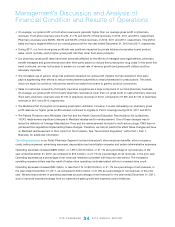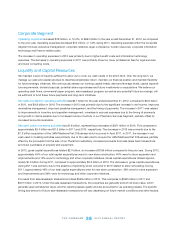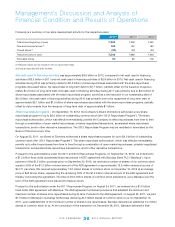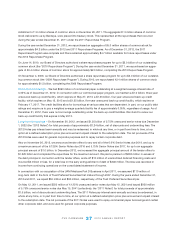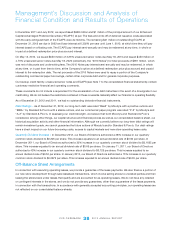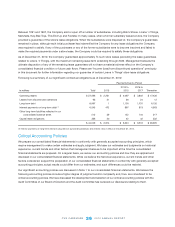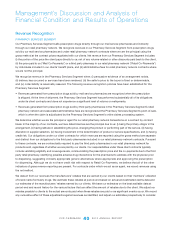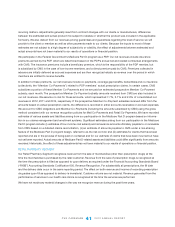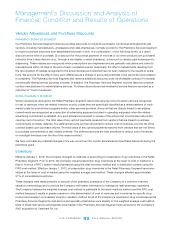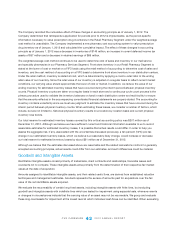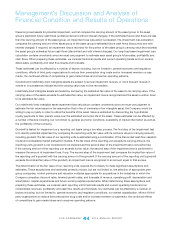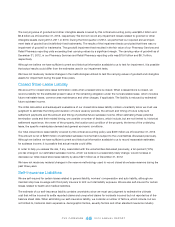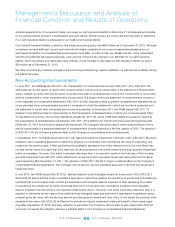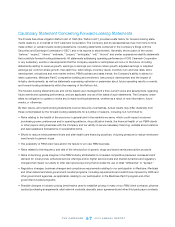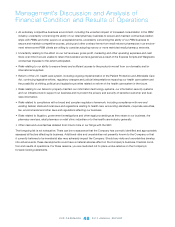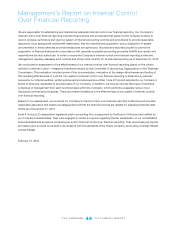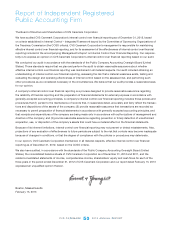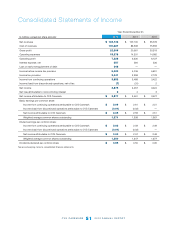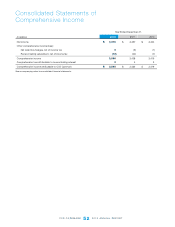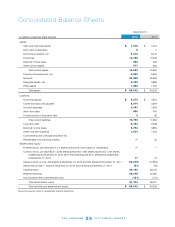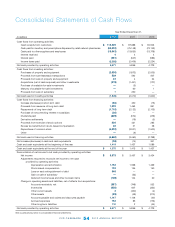CVS 2012 Annual Report Download - page 46
Download and view the complete annual report
Please find page 46 of the 2012 CVS annual report below. You can navigate through the pages in the report by either clicking on the pages listed below, or by using the keyword search tool below to find specific information within the annual report.Management’s Discussion and Analysis of
Financial Condition and Results of Operations
CVS CAREMARK 2012 ANNUAL REPORT
44
these long-lived assets for potential impairment, we first compare the carrying amount of the asset group to the asset
group’s estimated future cash flows (undiscounted and without interest charges). If the estimated future cash flows are less
than the carrying amount of the asset group, an impairment loss calculation is prepared. The impairment loss calculation
compares the carrying amount of the asset group to the asset group’s estimated future cash flows (discounted and with
interest charges). If required, an impairment loss is recorded for the portion of the asset group’s carrying value that exceeds
the asset group’s estimated future cash flows (discounted and with interest charges). Our long-lived asset impairment loss
calculation contains uncertainty since we must use judgment to estimate each asset group’s future sales, profitability and
cash flows. When preparing these estimates, we consider historical results and current operating trends and our consoli-
dated sales, profitability and cash flow results and forecasts.
These estimates can be affected by a number of factors including, but not limited to, general economic and regulatory
conditions, efforts of third party organizations to reduce their prescription drug costs and/or increased member co-pay-
ments, the continued efforts of competitors to gain market share and consumer spending patterns.
Goodwill and indefinitely-lived intangible assets are subject to annual impairment reviews, or more frequent reviews if
events or circumstances indicate that the carrying value may not be recoverable.
Indefinitely-lived intangible assets are tested by comparing the estimated fair value of the asset to its carrying value. If the
carrying value of the asset exceeds its estimated fair value, an impairment loss is recognized and the asset is written down
to its estimated fair value.
Our indefinitely-lived intangible asset impairment loss calculation contains uncertainty since we must use judgment to
estimate the fair value based on the assumption that in lieu of ownership of an intangible asset, the Company would be
willing to pay a royalty in order to utilize the benefits of the asset. Value is estimated by discounting the hypothetical
royalty payments to their present value over the estimated economic life of the asset. These estimates can be affected by
a number of factors including, but not limited to, general economic conditions, availability of market information as well as
the profitability of the Company.
Goodwill is tested for impairment on a reporting unit basis using a two-step process. The first step of the impairment test
is to identify potential impairment by comparing the reporting unit’s fair value with its net book value (or carrying amount),
including goodwill. The fair value of our reporting units is estimated using a combination of the discounted cash flow valuation
model and comparable market transaction models. If the fair value of the reporting unit exceeds its carrying amount, the
reporting unit’s goodwill is not considered to be impaired and the second step of the impairment test is not performed.
If the carrying amount of the reporting unit exceeds its fair value, the second step of the impairment test is performed to
measure the amount of impairment loss, if any. The second step of the impairment test compares the implied fair value of
the reporting unit’s goodwill with the carrying amount of the goodwill. If the carrying amount of the reporting unit’s goodwill
exceeds the implied fair value of the goodwill, an impairment loss is recognized in an amount equal to that excess.
The determination of the fair value of our reporting units requires the Company to make significant assumptions and
estimates. These assumptions and estimates primarily include, but are not limited to, the selection of appropriate peer
group companies; control premiums and valuation multiples appropriate for acquisitions in the industries in which the
Company competes; discount rates, terminal growth rates; and forecasts of revenue, operating profit, depreciation and
amortization, capital expenditures and future working capital requirements. When determining these assumptions and
preparing these estimates, we consider each reporting unit’s historical results and current operating trends and our
consolidated revenues, profitability and cash flow results and forecasts. Our estimates can be affected by a number of
factors including, but not limited to, general economic and regulatory conditions, our market capitalization, efforts of third
party organizations to reduce their prescription drug costs and/or increase member co-payments, the continued efforts
of competitors to gain market share and consumer spending patterns.


